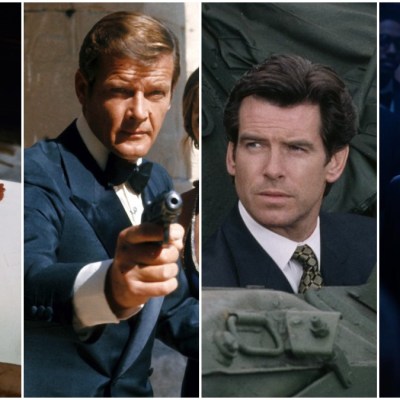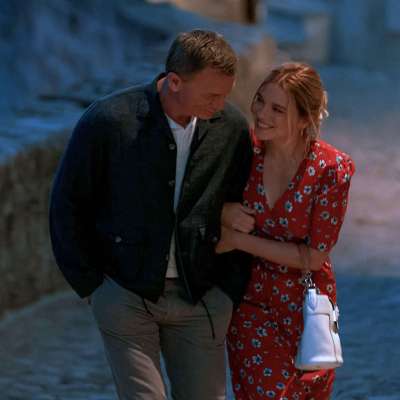The Good Movies Buried in the Original Casino Royale
The star-studded Casino Royale of 1967 is one of the most infamous disasters in Hollywood history, and generally the least loved of all James Bond movies. But there are lessons to be learned.

If you asked somebody to rank all the James Bond movies in order of quality (and it’s the sort of thing we might do), there would likely be many different opinions about which one took the top spot. But definitely up there near the top would be Casino Royale, the Daniel Craig-starring series reboot released in 2006 that was also based on the first Ian Fleming 007 novel.
If you went all the way to the other end of the list, and if you were including every Bond film ever made, not just the Eon Productions movies, you’d be likely to run into the name Casino Royale again. But this Casino Royale is not the gritty, hard-bitten, streamlined Bond of the 2006 picture. This movie, released in 1967, is, well, an artifact. A weirdness. It is loathed by purist fans, partly because the film itself was an utter catastrophe and partly because it put the breaks on any attempt at an Eon version of the first Bond novel for 40 years. Although some might say that delay paid off in the end.
If you’ve never seen the original big screen Casino Royale, it’s hard to articulate just what a bizarre mess the film is. The cast is stellar, featuring David Niven, Peter Sellers, Woody Allen, Deborah Kerr and Orson Welles, as well as the first official Bond Girl, Ursula Andress. Among the many writers, credited and uncredited, were Billy Wilder of The Apartment and Sunset Boulevard, and Joseph Heller, the novelist who wrote Catch-22.
Heller would go on to recount his experiences in the essay “How I Found James Bond, Lost My Self-Respect and Almost Made $150,000 in My Spare Time.”
Beneath it all, there is a good movie buried in there. Maybe more than one.
Not Your Granddad’s James Bond, or Anyone Else’s
There was no shortage of talent in the making of this film, and yet the result is barely watchable. Remember the bit in the Daniel Craig movie where Bond is racing to rescue Vesper Lynd, sees her tied up in the road, steers sharply to avoid hitting her, and overturns the car, waking up tied to a chair for the infamous “rope” scene?
That’s in this film as well, only before getting into the car, a Lotus Formula 3 that hasn’t been seen in the film until now, Bond delivers a nonsensical monologue to the camera in a Scottish accent, drives off, and then it cuts directly to him being tied to a (far more elaborate) chair with no explanation for how he got there.
When we’re introduced to Orson Welles’ Le Chiffre, he spends a lengthy amount of time performing elaborate stage magic for no reason other than Orson Welles wanted to do some stage magic during the shoot.
The film isn’t just sexist, it’s sexist by Bond movie standards. It’s not comic hyperbole to say that this film makes the Austin Powers movies look restrained. The whole first act is given over to a Scottish castle full of teenage girls trying to have sex with David Niven, and the evil scheme being Woody Allen (playing Jimmie Bond, James Bond’s nephew) trying to release a virus that will “make all women beautiful while wiping out all men over four foot six.”
At one point David Niven’s Bond is reunited with his estranged daughter, whose mother was real-life World War I spy, Mata Hari, and she says she fancies him too.
Then of course there’s the abundant racism, such as the film’s climax where an army of offensive Native American stereotypes parachute onto the set without warning, or the actual Baccarat game itself, which Peter Sellers uses as a chance to show us how many racist accents he can do.
At One Point a Flying Saucer Shows Up
That the film is such a mess is largely the result of its hugely troubled production, and there is no shortage of finger-pointing and rumors after the event.
The film feels like several different pictures hodgepodged together, and that’s because it is. The movie had no fewer than five directors, and then filmmaker Val Guest was given the task of splicing their work together into a cohesive film. He was offered the title of “coordinating director.” He declined the acknowledgement and instead chose the credit of “additional sequences by,” so that he wouldn’t be blamed for how the film turned out.
Casino Royale (2006) has been heralded as reinvigorating the franchise, reinventing Bond for the 21st century, distilling everything that made Bond great into one film. Casino Royale (1967), meanwhile, might as well be a guide on How Not To Do It.
And yet by the end of No Time To Die, you could be forgiven for feeling that maybe we’ve learned everything we can from Daniel Craig’s deeply flawed, damaged, and brutal take on Bond. If nothing else, the 1967 version offers an alternative vision.
The “Original” Bond
When Casino Royale came out in 1967, Sean Connery was about to release his fifth and supposedly final Bond movie, You Only Live Twice. At this point, Connery owned the role of Bond, and a lot of people would doubt whether someone else could successfully take on the character. Two years later, a lot of those people would say that George Lazenby had proved them right.
But Connery had not been Fleming’s first choice for the role. In fact, Fleming’s first choice was David Niven, the actor who would play the “original” James Bond, “Sir James Bond 007,” in Casino Royale.
When we first meet Niven’s Bond, he has retired, lives in a country estate (surrounded by lions), and has no interest in returning to serve Queen and Country. His opening monologue gives a very different, and damning interpretation of Bond from either the Eon movies or the Fleming books.
“In my day, spying was an alternative to war. The spy was a member of a select and immaculate priesthood, vocationally devoted, sublimely disinterested. Hardly a description of that sexual acrobat who leaves a trail of beautiful dead women like blown roses behind him.”
The sexual acrobat in question is “that bounder to whom you gave my name and number,” a not-so-subtle jab that implies Connery’s Bond is the imposter, given added edge once you know Niven was Fleming’s first choice.
The line “select and immaculate priesthood” is (probably) unintentionally echoed by Craig’s “half monk, half hitman” line in the Eon version of the movie, but it also portrays a version of Bond that’s a good deal more sympathetic and admirable than the murderous, misogynistic, state-sponsored killing machine that Craig initially portrayed. (One thing that has always elevated Craig’s version of Bond is his obvious contempt for the character. Once when asked what people could learn from Bond, Craig simply answered, “nothing.”)
A Lighter Bond?
It also introduces something that has been missing, or at least in short supply in the latest era of Bond films: self-awareness. Over the years, the Bond movies have swung from gritty to glamorous, from played dead straight to bordering on self-parody. The pendulum was tipped over and left for dead when the Austin Powers movies soared into the public consciousness at the end of the ‘90s, and Bond has been played with absolute seriousness ever since.
Of course, Bond’s not the only character to see this treatment. Right now people are flocking to cinemas to see a version of Batman that promises it’s grittier and more grounded than even the last two grittier and more grounded takes on Batman. But now that Bond has been actually killed off, the Great Reset offers opportunities.
Edgar Wright, of the Cornetto Trilogy, Baby Driver, and Last Night In Soho fame has suggested the new Bond films could go in a different direction. Describing Daniel Craig as a “dark chocolate” Bond, he says the franchise is “crying out for another milk chocolate Bond.”
In the podcast Happy Sad Confused, Wright said, “I don’t think there’s anything to be gained by continuing in the same vein, and I think it would certainly be interesting to try and… I mean, I do have a take [on Bond], and if they ever ask me, I’ll pitch it to them [laughs], so I’m not going to say it, but when I see some of the names being bandied around, I can’t quite see it, and they seem like Daniel Craig II.”
Of course while David Niven might have been Fleming’s first choice to play Bond, he was also far from the only Bond to appear in the original Casino Royale.
Enter-the-Bond-Verse
As we’ve already said, when Casino Royale was released there was only one Bond, James Bond, and that was Sean Connery.
Casting Niven as the “original” Sir James Bond was a joke aimed at casting shade on Connery’s character, but the joke didn’t end there. As well as revealing that MI6 is passing on Bond’s name and number to subsequent agents, as the film goes on, Bond comes up with the idea of confusing the enemy by recruiting a band of new agents and calling them all James Bond, giving them all the serial number 007.
So we get Peter Sellers as Evelyn Tremble as James Bond, Vesper Lynd (Ursula Andress) is given the serial number 007, and Terence Cooper as Cooper, a James Bond 007, who has the ability to not be seduced by beautiful women, among others.
Unwittingly the film predicts one of the Great Unified Fan Theories of James Bond.
Two years later, in the opening of On Her Majesty’s Secret Service where George Lazenby rescues a woman from an attacker only to have her speed off and leave him, he quips, “This never happened to the other fella.” It’s a gag, but it implies that this “James Bond” is not the James Bond we’ve seen for the last five films.
Trying to find a unified canon of James Bond films makes sorting out Doctor Who continuity seem attainable. Each film is extremely its own thing, but strands keep drifting from one film to the next. Even when Craig came onboard for the hardest of hard reboots, his M was Judy Dench, the same M that berated Pierce Brosnan for his outdated, Cold War-era attitudes in the ‘90s.
A popular theory is that one laid out by the 1967 Casino Royale itself: that James Bond 007 is a title, handed down across the agency. Always orphans, always particularly dashing and deadly, but still, different people.
Skyfall very might’ve confirmed the theory when it planned to cast Connery as the gamekeeper of Bond’s childhood home.
But is this a theory whose time has finally come?
After all, we are living in the age of the multiverse, with not one but three Spider-Verse moves released in the last few years, with multiple Jokers and Batmen in production at any given time, and the MCU and X-Men and Sony Spider-Universes crossing over with each other willy-nilly.
Some of it is pure fan service, of course, but at the same time, these stories can be a way of viewing the character from several angles at once, refining them down to the purest element that makes them work and showing the different things you can do with that.
The execution of Casino Royale is beyond flawed, but the kernel of the idea, a meta, even slightly-comedic James Bond movie, where the name and title are bestowed on a variety of different interpretations of the character at once, each of them having to learn to be James Bond. That could be the perfect Bond movie for our time.
Also at some point there should be a flying saucer.


